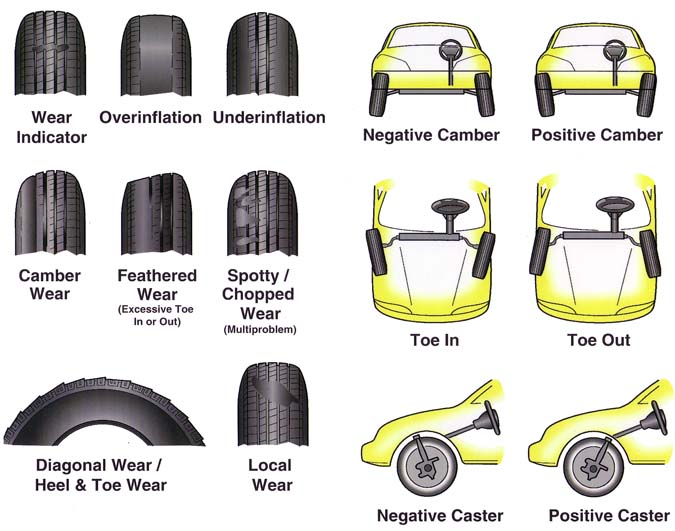In the world of automobiles, tires are often subjected to various forces that can cause premature wear. One of the most prevalent issues arises from uneven tire wear, particularly on the inner or outer edges. This phenomenon, known as camber wear, occurs when the tires are not perpendicular to the ground due to misalignment of the suspension components. If left unattended, camber wear not only compromises the tire’s lifespan but also impairs vehicle handling and safety.

Image: www.city-data.com
With the plethora of information available online, addressing camber wear may seem like a daunting task to tackle on your own. However, armed with the right knowledge and guidance, you can effectively diagnose and resolve this issue, ensuring optimal tire performance and overall vehicle safety.
Delving into Camber: Understanding the Root of the Problem
Camber, simply put, refers to the inward or outward tilt of your vehicle’s tires as they rest on the ground when viewed from the front or back of the car. This angle plays a crucial role in maintaining proper tire contact with the road surface, affecting stability, cornering abilities, and overall vehicle handling.
Misalignment occurs when the camber angle deviates from its intended specifications. This misalignment can manifest in two primary forms:
- Negative camber: when the wheel tilts inward at the top
- Positive camber: when the wheel tilts outward at the top
While some degree of negative camber is often employed in performance vehicles to enhance handling during cornering, excessive negative or positive camber can result in accelerated and uneven tire wear, particularly on the inner or outer edges of the tires.
Identifying Camber Wear: Spotting the Signs of Misalignment
Recognizing the symptoms of camber wear is essential to its timely remediation. Here are some telltale signs to watch out for:
- Uneven tread wear: Noticeable differences in tread depth across the width of the tire
- Inner or outer edge wear: Excessive wear on the inside (negative camber) or outside (positive camber) of the tire
- Shoulder wear: Pronounced wear on the shoulder blocks of the tire, usually caused by excessive positive camber
- Feathering: A scalloped pattern on the tire tread, often indicating suspension problems
If you suspect your vehicle exhibits camber wear, prompt inspection and alignment are highly recommended to prevent further damage to your tires and preserve overall vehicle performance.
Addressing Camber Wear: Restoring Balance and Functionality
Correcting camber wear involves realigning the vehicle’s suspension components to restore the correct camber angles. This typically entails adjustments to the control arms, tie rods, and other suspension linkages. In some cases, additional components may require replacement.
It’s important to entrust this task to qualified mechanics who possess the expertise and equipment to diagnose the root cause of the misalignment accurately. Using specialized measuring tools, they can precisely adjust the suspension components to within the vehicle’s specified parameters.
Image: www.quora.com
The Essence of Regular Alignment: A Preventative Regimen
Regular tire alignment is paramount in maintaining optimal tire health and prolonging their lifespan. Over time, suspension components can naturally shift or loosen, altering the alignment settings. Factors contributing to these changes include road conditions, driving habits, and impact from potholes or collisions.
Scheduling routine alignment checks every 6,000-10,000 miles is advisable to maintain proper camber and other alignment angles. This proactive measure will significantly minimize premature tire wear, improve handling, and enhance overall vehicle safety.
How To Fix Camber Wear On Tires
Empowering Yourself: DIY Alignment Checks and Maintenance
While alignment checks and adjustments are best left to professionals, there are some preliminary steps you can take to help keep your tires in check:
- Visual inspection: Regularly examine your tires for uneven wear patterns or other signs of misalignment.
- Tire pressure monitoring: Ensure proper tire inflation pressure according to the vehicle’s specifications, as underinflated or overinflated tires can contribute to accelerated and uneven tread wear.
- Avoid aggressive driving: Limit abrupt acceleration, braking, and cornering, as these maneuvers can put undue stress on the suspension and lead to premature tire wear.
- Suspect misalignment? Immediately seek professional assistance if you notice significant tire wear or any unusual handling behavior, such as drifting or pulling to one side while driving. Early detection and resolution can prevent further damage and more costly repairs.
Remember, safeguarding your vehicle’s tires against camber wear and ensuring proper alignment are critical for maintaining optimal performance, maximizing tire lifespan, and ensuring a safe and enjoyable driving experience.